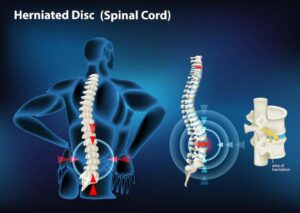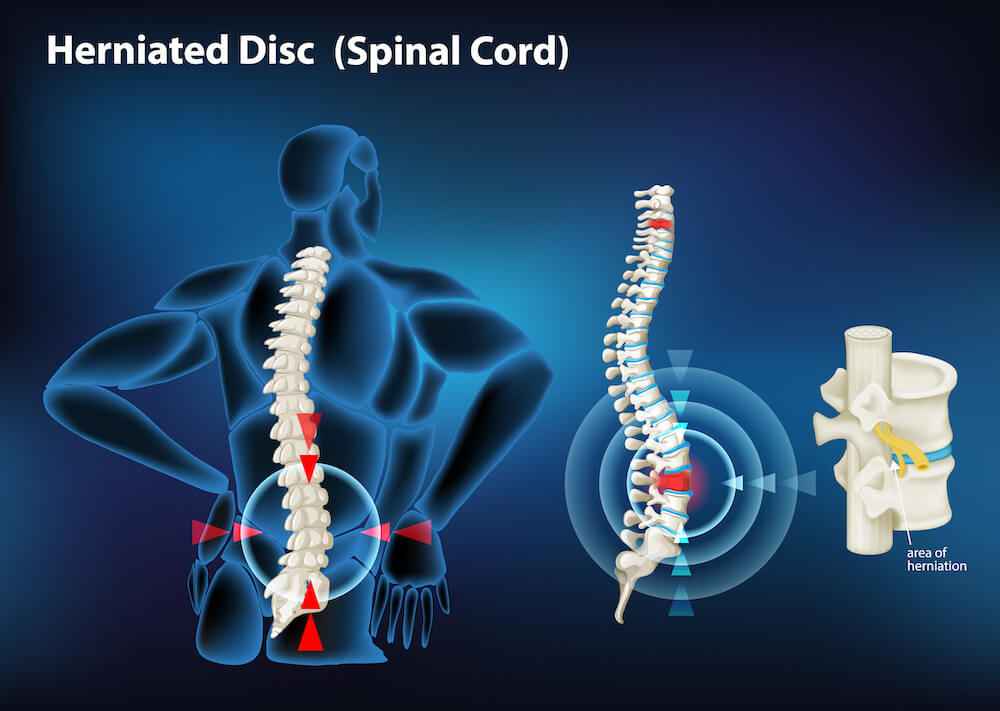If you are struggling with a herniated disc, physical therapy may be the answer for you. A herniated disc can cause a lot of pain and discomfort, which can make it difficult to live your life normally. Physical therapy is a great way to treat this condition and help you get back to your normal self. In this blog post, we will discuss the benefits of physical therapy and how it can help you recover from a herniated disc.
Contents
- 1 Defining Herniated Disc
- 2 Is it possible to heal a herniated disc with physical therapy?
- 3 What Kind Of Physical Therapy Will Heal A Herniated Disc?
- 4 What Types Of Physical Therapy Used To Treat Herniated disc?
- 5 The Types Of Physical Therapy Exercises For Herniated Disc
- 6 How often should you do physical therapy for a herniated disc?
- 7 What To Avoid In Herniated disc?
- 8 What Are The Benefits Of Physical Therapy For Herniated Disc?
- 9 What Are The Risks Of Physical Therapy For Herniated Disc?
- 10 Conclusion
Defining Herniated Disc

A herniated disc occurs when the jelly-like center of a spinal disc ruptures through a tear in the tougher outer layer. This can put pressure on the spinal cord or nerves, leading to pain, numbness, and weakness. Disc herniation is also called a slipped disc, ruptured disc, or pinched nerve.
Is it possible to heal a herniated disc with physical therapy?
Yes, physical therapy is often used as a treatment for herniated discs. The goal of physical therapy is to help relieve pain and improve function. There are many different techniques that may be used, including exercises, stretches, and manual therapy. Your therapist will work with you to create a custom treatment plan that meets your needs.
A large number of herniated disks do not need surgery and physically heal with therapies. By designing personalized treatment programs, physical therapists help people suffering from a herniated disk to get back to their daily activities.
What Kind Of Physical Therapy Will Heal A Herniated Disc?
If you’ve been dealing with the pain of a herniated disc, you may be wondering if physical therapy can help. The answer is yes! Physical therapy can be an extremely effective treatment for a herniated disc, and it may even help you avoid surgery.
Deep tissue massage, hot/cold therapies, and hydrotherapy are all methods of physical therapy that can often help with herniated disc recovery. Not only do they offer immediate pain relief, but they also teach you how to condition your body to prevent further injury.
What Types Of Physical Therapy Used To Treat Herniated disc?

There are several different types of physical therapy that can be used to treat a herniated disc. Your doctor or physical therapist will likely recommend one or more of the following:
Deep tissue massage
Massaging the affected area can help to reduce inflammation and pain. Deep tissue massage is especially beneficial if your herniated disc is causing radiating pain. For instance, if your herniated disc is in your lower back and you’re experiencing pain down your leg, deep tissue massage can help to relieve that pain.
Hot/cold therapies
Applying hot or cold packs to the affected area can help to reduce pain and inflammation. Hot therapies should not be used if you have nerve damage, as they could make the condition worse. For example, a recent study found that people who underwent 12 weeks of physical therapy for a herniated disc had significantly less pain and disability than those who didn’t receive any treatment. Other studies have shown that traction, which involves stretching the spine, can also be effective in relieving pain from a herniated disc
Hydrotherapy
Exercising in water is a great way to take pressure off of your spine and ease the pain. Water-based exercises are also beneficial because they help to improve the range of motion and increase muscle strength. For instance, you can do water-based exercises such as walking, jogging, or swimming to help improve your symptoms.
Massage therapy
Massage therapy can help to reduce inflammation and muscle spasms. It can also help to increase blood flow to the affected area, which can speed up the healing process. For instance, one study found that massage therapy was effective in reducing pain and improving function in people with chronic low back pain.
Heat and ice therapy
Applying heat and ice to the affected area can help to reduce pain and inflammation. For instance, you might try placing a heating pad on your lower back for 20-30 minutes at a time. Or, you could apply an ice pack wrapped in a towel to the area for 10-15 minutes every few hours.
Exercise
Exercise is important for overall health, but it is also crucial for herniated disc recovery. Not only will exercise help to reduce pain, but it will also improve your flexibility and range of motion These exercises may be done in a group setting or one-on-one with a physical therapist.
Manual therapy
This type of physical therapy involves the therapist using their hands to apply pressure and manipulate the soft tissues and joints around the spine. This can help to release tension and improve the range of motion. For example, the therapist may use their hands to massage the muscles around the spine or perform mobilization techniques.
The Types Of Physical Therapy Exercises For Herniated Disc
Aerobic exercises: These exercises help to increase your heart rate and improve your overall cardiovascular health. They also promote healing by increasing blood flow to the affected area.
Stretching exercises: These exercises help to improve flexibility and range of motion. They can also help to reduce pain and muscle spasms.
Strengthening exercises: These exercises help to increase muscle strength and endurance. They can also help to improve overall function.
If you are struggling with a herniated disc, physical therapy may be the answer. Talk to your doctor or physical therapist to find out which type of physical therapy is right for you.
How often should you do physical therapy for a herniated disc?
If you’ve been diagnosed with a herniated disc, your doctor may recommend that you try physical therapy as a treatment option. But how often should you go?
The answer may depend on the severity of your symptoms and the underlying cause of your herniated disc. For example, if your herniated disc is the result of an injury or a degenerative condition, you may need to go more frequently at first.
It is crucial that you get in some activity every couple of hours during the day. Two to three sets a day isn’t going to cut it. If you’re feeling any symptoms, try exercising as soon as possible – it might just give you some relief from your symptoms.
What To Avoid In Herniated disc?
If you have a herniated disc, there are certain activities that you should avoid. These include:
- Bending forward at the waist
- Lifting heavy objects
- Twisting your body
These activities can put additional strain on your back and make your condition worse. If you must lift something heavy, be sure to use proper lifting techniques.
What Are The Benefits Of Physical Therapy For Herniated Disc?

There are many benefits of physical therapy for a herniated disc. These include:
Reduce pain and inflammation
Physical therapy can help to reduce the pain and inflammation associated with a herniated disc. For instance, your physical therapist may use ice or heat to help reduce inflammation. For example, you might use an ice pack for 20 minutes, followed by a heat pack for 20 minutes.
Improve mobility
Physical therapy can help to improve your mobility and range of motion. For example, if your herniated disc is causing sciatica (pain that radiates down your leg), your physical therapist may prescribe exercises that stretch and strengthen the muscles in your leg and back. This can help to take pressure off of your disc and relieve pain.
Strengthen muscles
Physical therapy can help to strengthen the muscles around the herniated disc, which can help to stabilize the spine. For instance, exercises that strengthen the abdominal muscles can help to take some of the pressure off of the spine.
A herniated disc can be a very painful condition, but there are treatments available that can help. One option is physical therapy, which can help to strengthen the muscles around the herniated disc and take some of the pressure off of the spine.
Prevent further injury
Physical therapy can help to prevent further injury to the spine.For instance, if you have a herniated disc, your physical therapist can teach you how to safely move and lift objects to avoid putting additional strain on your spine.
In addition, a physical therapist can create an individualized exercise program for you that will help to strengthen the muscles around your spine and improve your flexibility.
Decrease muscle spasms
Physical therapy can help to decrease muscle spasms. For instance, your physical therapist may provide you with low-level laser therapy. This type of therapy can help to significantly reduce pain and muscle spasms.
Improve flexibility
One of the primary goals of physical therapy for a herniated disc is to improve flexibility in the spine and the surrounding muscles. This improved flexibility can help take pressure off of the disc and prevent further injury.
Build strength
In order to take pressure off of the disc and protect it from future injury, it is important to build up the strength of the muscles surrounding the spine. Physical therapy can help to strengthen these muscles, providing support for the spine and preventing further injury.
Relieve pain
One of the primary goals of physical therapy for a herniated disc is to relieve pain. This can be done through a variety of methods, including exercises, stretches, and other techniques.For instance, your physical therapist may have you do exercises that help strengthen the muscles around the affected area. This can help take some of the pressure off of the disc, which can in turn help reduce pain.
Improve overall function
The goal of physical therapy is to help patients improve their overall function. This may involve working on a range of motion, flexibility, strength, and endurance. For example, if you have a herniated disc in your lower back, physical therapy may involve exercises that stretch and strengthen the muscles in your back and core. This can help to take pressure off of the herniated disc and alleviate pain.
If you are suffering from a herniated disc, physical therapy may be the answer. With improved flexibility, strength, and pain relief, physical therapy can help you recover from your injury and prevent further damage.
What Are The Risks Of Physical Therapy For Herniated Disc?
There are some risks associated with physical therapy for a herniated disc. These include:
Pain: Some exercises may cause short-term pain. However, this pain should subside as your condition improves. For instance, someone with a herniated disc may experience pain while doing an exercise that causes them to bend forward at the waist. This is because this movement may put additional pressure on the discs in your spine. if your therapist asks you to do an activity that causes pain, stop and let them know.
Injury: There is a small risk of injury when participating in physical therapy. However, this risk can be minimized by following your therapist’s instructions and avoiding activities that are beyond your current level of ability. For example,
If your therapist asks you to perform an exercise that is too difficult, tell them so they can modify the exercise for you.
It’s important to warm up before participating in any physical activity, including physical therapy. Warming up helps increase blood flow to your muscles and reduce the risk of injury. A good warm-up should consist of 5-10 minutes of light activity, such as walking or light stretching.
Conclusion
It may be concluded that physical therapy for herniated discs is a very effective and necessary treatment for this condition. It can help to improve the symptoms and quality of life for those who suffer from herniated discs. This type of therapy should be performed by a qualified physical therapist in order to maximize the results. If you are struggling with a herniated disc, don’t hesitate to ask your doctor if physical therapy could help you.
Physical Therapy help patients recover from pain. If you’re experiencing Back pain, Shoulder pain, Knee pain, Neck pain, Elbow pain, Hip pain, or Arthritis pain, a physical therapist at MantraCare can help: Book a physiotherapy session.


